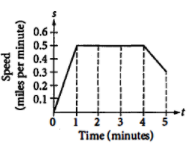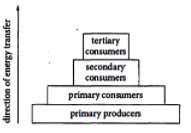Question
The function f has the property that, for all x , 3f(x) = f(3x). If f(6) = 12, what is the value of f(2)?
The correct answer is: 4
3 f (x) = f (3x)
f (6) = 12
f (3 × 2) = 3f (2) = 12
3f (2) = 12
= f (2) = 4
Related Questions to study
Radioactive substances decay over time. The mass M, in grams, of a particular radioactive substance d days after the beginning of an experiment is shown in the table below.
|
Number of days, d |
Mass, M (grams) |
|
0 |
120.00 |
|
30 |
103.21 |
|
60 |
88.78 |
|
90 |
76.36 |
Radioactive substances decay over time. The mass M, in grams, of a particular radioactive substance d days after the beginning of an experiment is shown in the table below.
|
Number of days, d |
Mass, M (grams) |
|
0 |
120.00 |
|
30 |
103.21 |
|
60 |
88.78 |
|
90 |
76.36 |
The table below shows the number of lakes in the United Kingdom classified by alkalinity and depth.
|
Depth class |
Alkalinity Class |
|||
|
Low |
Medium |
High |
Total |
|
| Shallow |
87 |
61 |
209 |
357 |
| Moderate |
227 |
86 |
110 |
423 |
| Deep |
130 |
35 |
21 |
186 |
| Total |
444 |
182 |
340 |
966 |
The table below shows the number of lakes in the United Kingdom classified by alkalinity and depth.
|
Depth class |
Alkalinity Class |
|||
|
Low |
Medium |
High |
Total |
|
| Shallow |
87 |
61 |
209 |
357 |
| Moderate |
227 |
86 |
110 |
423 |
| Deep |
130 |
35 |
21 |
186 |
| Total |
444 |
182 |
340 |
966 |
a(-3x-1) + x = 7x - 2
The equation above has no solutions, and a is a constant. What is the value of a ?
a(-3x-1) + x = 7x - 2
The equation above has no solutions, and a is a constant. What is the value of a ?
A signal from a spacecraft orbiting Mercury travels to Earth at a speed of 3 x 108 meters per second. If the distance between Earth and the spacecraft is 2.0221 x 108 kilometers, which of the following ·is closest to the number of minutes it will take for a signal from the spacecraft to reach Earth?
(1 kilometer= 1,000 meters)
A signal from a spacecraft orbiting Mercury travels to Earth at a speed of 3 x 108 meters per second. If the distance between Earth and the spacecraft is 2.0221 x 108 kilometers, which of the following ·is closest to the number of minutes it will take for a signal from the spacecraft to reach Earth?
(1 kilometer= 1,000 meters)
y = (x-h)2 (x+h)(x+k)
The equation above is graphed in the xy-plane. If h and k are positive constants and h  k, how many distinct x-intercepts does the graph have?
k, how many distinct x-intercepts does the graph have?
y = (x-h)2 (x+h)(x+k)
The equation above is graphed in the xy-plane. If h and k are positive constants and h  k, how many distinct x-intercepts does the graph have?
k, how many distinct x-intercepts does the graph have?

The scatterplot above represents the salary y, in thousands of dollars, and the number of years of experience, x, for each of six employees at a company. A line of best fit for the data is also shown. Which of the following could be an equation of the line of best fit?

The scatterplot above represents the salary y, in thousands of dollars, and the number of years of experience, x, for each of six employees at a company. A line of best fit for the data is also shown. Which of the following could be an equation of the line of best fit?
x(x + 1) + 2(x + 1) = ax2 +bx+ c
In the equation above, a, b, and c are constants. If the equation is true for all values of x, what is the value of a + b + c ?
x(x + 1) + 2(x + 1) = ax2 +bx+ c
In the equation above, a, b, and c are constants. If the equation is true for all values of x, what is the value of a + b + c ?
kx+ y = 1
y = -x2 + k
In the system of equations above, k is a constant. When the equations are graphed in the xy-plane, the graphs intersect at exactly two points. Which of the following CANNOT be the value of k ?
kx+ y = 1
y = -x2 + k
In the system of equations above, k is a constant. When the equations are graphed in the xy-plane, the graphs intersect at exactly two points. Which of the following CANNOT be the value of k ?
y=x2 -6x - 16
The graph of the equation above in the xy-plane is a parabola. Which of the following equivalent forms of the equation includes the x- and y-coordinates of the
vertex as constants?
y=x2 -6x - 16
The graph of the equation above in the xy-plane is a parabola. Which of the following equivalent forms of the equation includes the x- and y-coordinates of the
vertex as constants?
s = 9.8t
The equation above can be used to approximate the speed s, in meters per second (m/s), of an object t seconds after being dropped into a free fall. Which of the following is the best interpretation of the number 9.8 in this context?
s = 9.8t
The equation above can be used to approximate the speed s, in meters per second (m/s), of an object t seconds after being dropped into a free fall. Which of the following is the best interpretation of the number 9.8 in this context?

Note: Figure not drawn to scale.
In the figure above, sin(90° - x0) =  . What is the value of sin x0 ?
. What is the value of sin x0 ?

Note: Figure not drawn to scale.
In the figure above, sin(90° - x0) =  . What is the value of sin x0 ?
. What is the value of sin x0 ?

The graph above models the speed, s, of an automobile during the first 5 minutes of travel time, t. What was the total distance traveled from t=1 to t=4?

The graph above models the speed, s, of an automobile during the first 5 minutes of travel time, t. What was the total distance traveled from t=1 to t=4?
The energy pyramid below shows four trophic levels in an ecosystem and the direction of energy transfer between those levels.

On average, 10% of the net energy of one trophic level is transferred to the next trophic level in an ecosystem. Based on the energy pyramid, if primary producers have 5,000 joules (J) of energy, approximately how much of this energy, in calories, is transferred to the secondary consumers in this ecosystem? (1 calorie= 4.18 J)
Energy flow direction within an ecosystem
1. An ecosystem's energy flow is always unidirectional.
2. It is said to be unidirectional because energy is lost in heat when moving from one trophic level to the next to maintain an organism's homeostasis.
3. As a result, each successive trophic level receives less energy than the previous trophic level.
4. Some energy is lost as heat when an organism moves from one trophic level to the next to maintain homeostasis.
5. As a result, each successive trophic level receives less energy than the previous trophic level.
6. Because the sun is the only energy source for all ecosystems on Earth, the energy flow in the food chain is unidirectional.
7. The energy captured by autotrophs does not return to the sun.
8. As a result, energy flows through various trophic levels in a food chain.
9. Energy comes from the sun and is consumed by producers in most natural ecosystems.
10. It is then passed down through the trophic levels as food.
11. As a result, energy flows from the prey to the predator rather than the other way around.
The energy pyramid below shows four trophic levels in an ecosystem and the direction of energy transfer between those levels.

On average, 10% of the net energy of one trophic level is transferred to the next trophic level in an ecosystem. Based on the energy pyramid, if primary producers have 5,000 joules (J) of energy, approximately how much of this energy, in calories, is transferred to the secondary consumers in this ecosystem? (1 calorie= 4.18 J)
Energy flow direction within an ecosystem
1. An ecosystem's energy flow is always unidirectional.
2. It is said to be unidirectional because energy is lost in heat when moving from one trophic level to the next to maintain an organism's homeostasis.
3. As a result, each successive trophic level receives less energy than the previous trophic level.
4. Some energy is lost as heat when an organism moves from one trophic level to the next to maintain homeostasis.
5. As a result, each successive trophic level receives less energy than the previous trophic level.
6. Because the sun is the only energy source for all ecosystems on Earth, the energy flow in the food chain is unidirectional.
7. The energy captured by autotrophs does not return to the sun.
8. As a result, energy flows through various trophic levels in a food chain.
9. Energy comes from the sun and is consumed by producers in most natural ecosystems.
10. It is then passed down through the trophic levels as food.
11. As a result, energy flows from the prey to the predator rather than the other way around.





